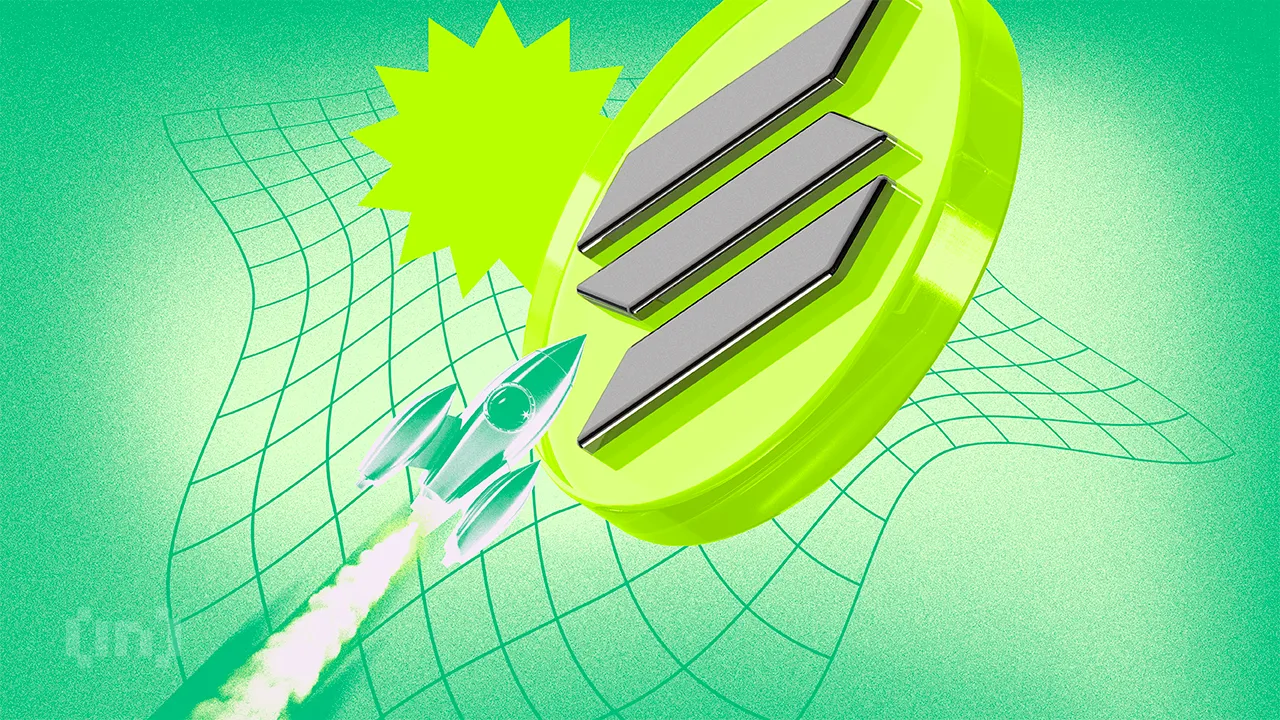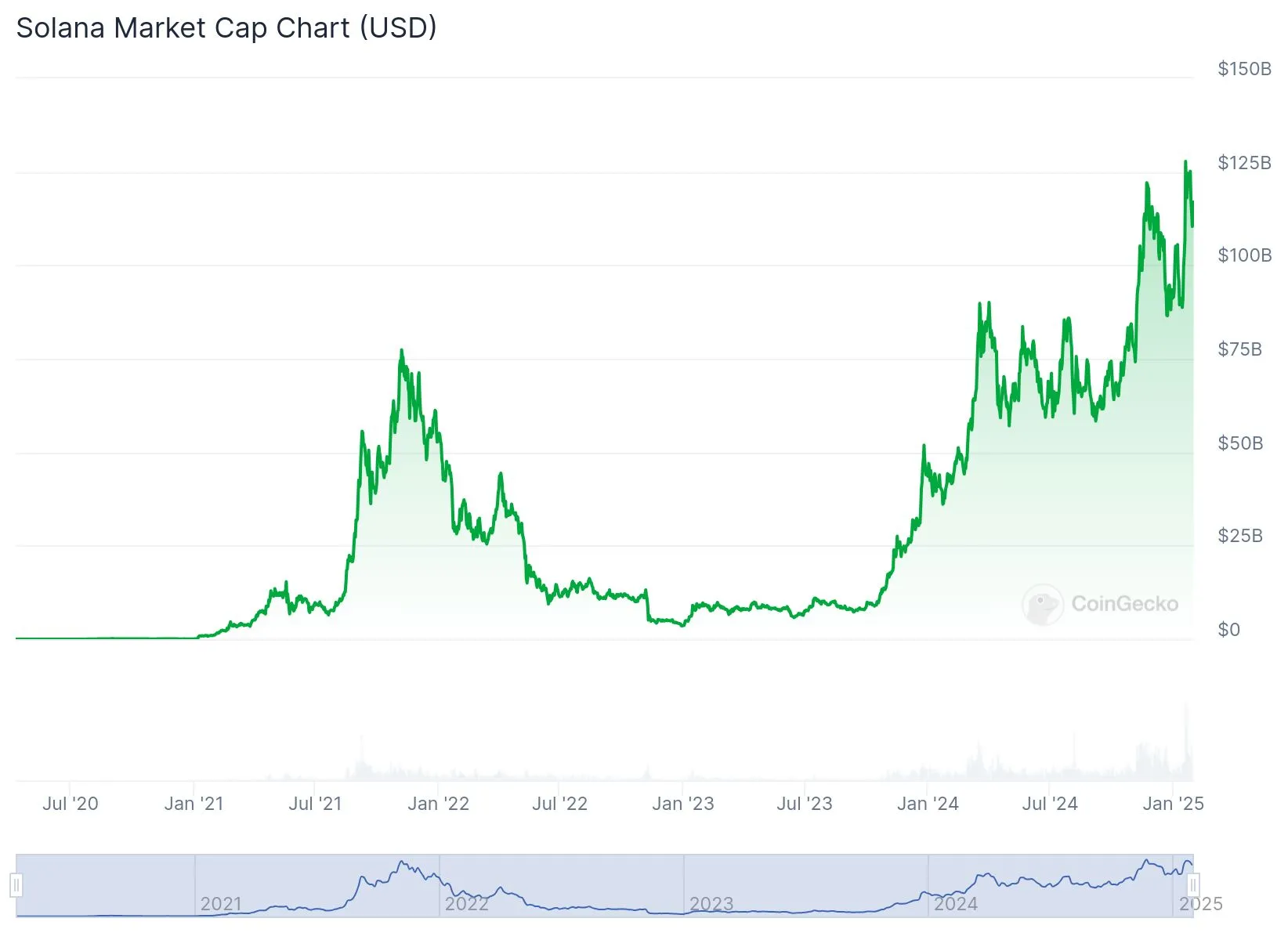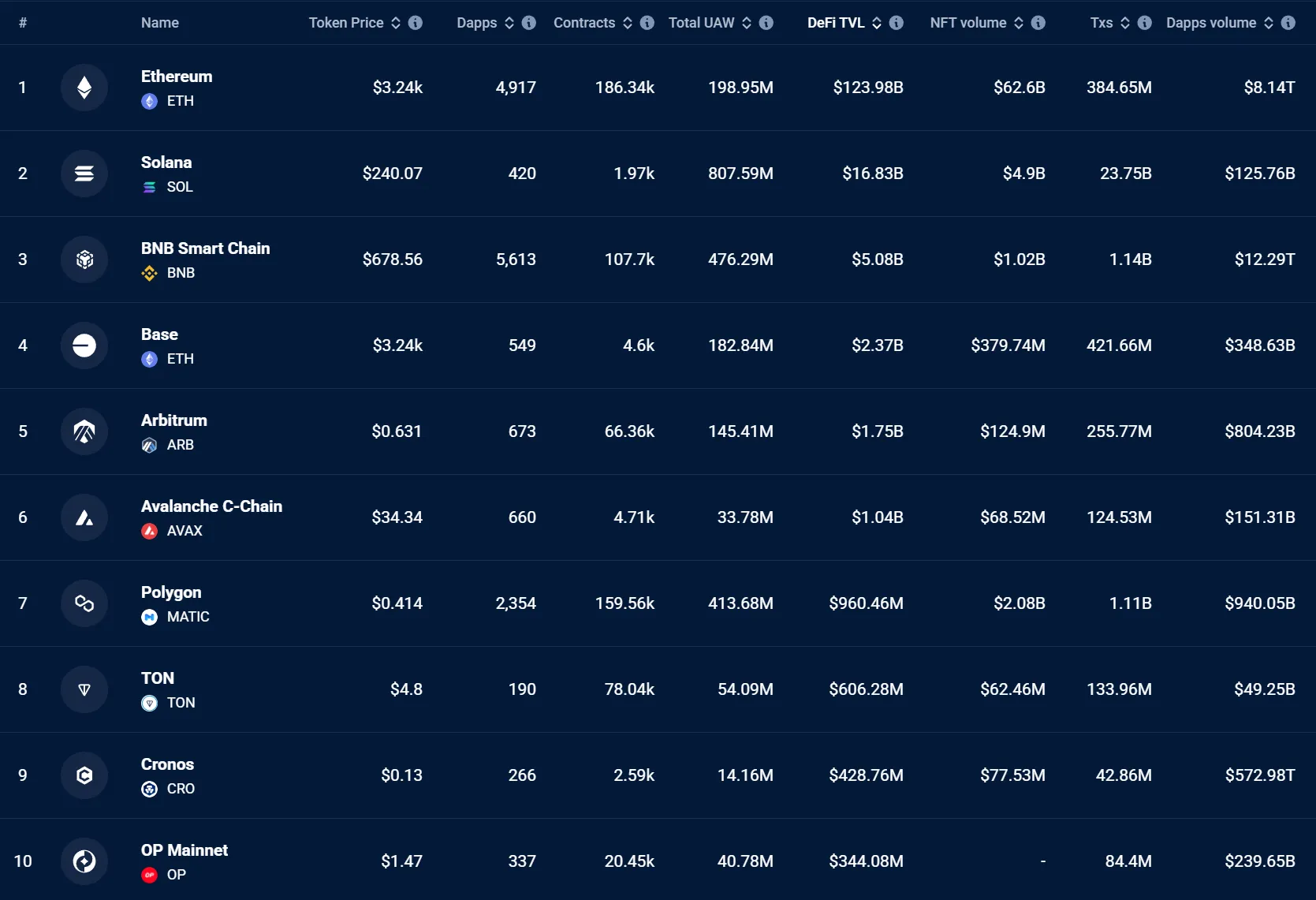Market
Solana Has a Long Way to Go Before It Can Surpass Ethereum

Solana has experienced exponential growth since it first entered the market as an alternative Layer-1 blockchain. Though the network’s market capitalization is still significantly smaller than Ethereum, its top contender, this gap has shrunk considerably over the years.
As Solana grows, some wonder whether it will displace Ethereum as the second-largest cryptocurrency behind Bitcoin. In a conversation with BeInCrypto, Juan Pellicer, Senior Research Analyst at IntoTheBlock, said Solana still has to overcome several hurdles before that can occur.
Following Bitcoin, Ethereum has solidified its position as a leading cryptocurrency, pioneering the concept of smart contracts and establishing itself as the dominant platform for decentralized applications.
However, Ethereum’s dominance has been challenged by the emergence of competitors like Solana, which entered the market in March 2020 as an alternative layer-1 blockchain network.
While Ethereum maintains a significant market capitalization advantage over Solana, this advantage has notably shrunk over the years.
Since its launch in March 2020, Solana’s market capitalization reached its first peak in November 2021, when it reached $72.4 billion. One week ago, the token surpassed the $100 billion mark, reaching a new all-time high.

At the time of writing, Ethereum’s market cap is $392 billion. While its advantage over Solana is significant, some have begun to wonder how long Solana needs to surpass Ethereum.
As the network exceeds key metrics like daily active users, daily transactions, and the number of new addresses created monthly, some say 2025 will be the year Solana takes the second-place trophy.
Though Solana’s success is impressive, according to Pellicer, it still lacks what it takes to overthrow Ethereum.
“While Solana may continue to grow and potentially challenge Ethereum in specific niches, overcoming Ethereum’s entrenched position as the dominant platform in the immediate future is still unlikely, though the competitive landscape is dynamic and evolving,” he said.
Pellicer considered many factors before coming to that conclusion.
High Throughput and Low Transaction Costs Maintain Solana’s Competitiveness
Solana and Ethereum boast particular strengths that, in turn, attract different audiences.
Ethereum’s continued dominance is largely due to its established trust, widespread adoption, and ongoing development efforts. As the first platform to enable the development of decentralized applications, Ethereum continues to lead the market, powering most decentralized finance (DeFi) projects and hosting major non-fungible token (NFT) marketplaces.
“Ethereum’s infrastructure is unmatched in economic security, maintaining a flawless uptime record since inception, which fosters unparalleled trust for institutional and high-value applications. Its DeFi ecosystem remains the most mature, with pioneering protocols setting industry standards, though competitors like Solana are rapidly closing the gap with faster, cheaper alternatives,” Pellicer told BeInCrypto.
Solana’s competitive edge comes from its high throughput and low transaction costs. The network uses two consensus mechanisms: Proof-of-History (PoH) and Proof-of-Stake (PoS).
The combination of PoS and PoH allows individual nodes to validate the entire blockchain using only a small piece of information. This is possible because PoH creates a verifiable history of transactions, which means a node doesn’t need to be constantly connected to the network to verify its validity. In turn, transaction speeds are much faster.
Originally running on a Proof-of-Work (PoW) consensus mechanism, Ethereum transitioned to PoS in September 2022. Regardless, the network often suffers from congestion and slow transaction speeds.
While Ethereum can only process around 15 transactions per second, Solana can handle over 2,600.
“This results in a smoother user experience, particularly for high-frequency applications and retail users. This technological differentiation, coupled with effective marketing and a vibrant ecosystem of applications focused on speed and affordability, has fueled Solana’s rapid growth and market cap increase, attracting users and projects seeking alternatives to Ethereum’s higher gas fees and slower transaction finality,” Pellicer explained.
However, Ethereum has other advantages that outweigh Solana’s speed.
Ethereum Excels in DeFi
Since its launch in 2015, Ethereum has become a widely used blockchain platform for developers and enterprises.
The platform’s smart contract functionality has enabled the creation of numerous decentralized applications (dApps), contributing to the growth of ecosystems focused on DeFi, gaming, and NFTs.

Today, Ethereum’s DeFi total value locked (TVL) stands at nearly $124 billion.
“This creates deep liquidity, robust infrastructure, and a rich ecosystem, making it difficult for newer platforms like Solana to replicate quickly. This entrenched network effect provides Ethereum with significant inertia and competitive advantage, as users and developers benefit from the existing infrastructure, community support, and established protocols within the Ethereum ecosystem,” Pellicer said.
A strong driver behind Ethereum’s solid developer base is its use of Solidity as its base programming language.
Solidity is a language specifically designed for smart contracts and the Ethereum Virtual Machine (EVM). It benefits from a mature ecosystem, extensive tooling, and a large pool of already proficient developers.
Solana’s core programming language is Rust. This system offers advantages in terms of rapid performance rates and overall safety.
“While Rust offers advantages in terms of execution speed and security, it has a steeper learning curve and a smaller developer community within the blockchain space compared to Solidity. This difference can impact developer adoption rates and the types of applications built, with Ethereum attracting a broader range of developers initially, while Solana may appeal to those focused on performance-critical applications and those already familiar with Rust,” Pellicer added.
Ethereum also remains the preferred network for users who prioritize decentralization before speed.
Solana Centralization Concerns
Solana’s validator node requirements, which demand significant hardware investments, can create barriers to entry, potentially leading to a concentration of power within the network among those capable of affording the necessary infrastructure.
While Solana currently has around 2,000 active validators, Ethereum passed the one million benchmark last year– the largest number recorded by any blockchain network. Though Solana’s reliance on this type of hardware expedites the network, this has raised concerns about whether this high-efficiency rate comes at the cost of decentralization.
During last October’s Token2049 conference, whistleblower Edward Snowden gained attention for bringing up this point.
Speaking through a video link, Snowden raised concerns that Solana’s focus on speed and efficiency comes at the cost of decentralization, which he sees as essential for keeping blockchain technology trustworthy. He also said that it makes the network more susceptible to government interference.
His comments reflected doubts shared by many crypto community members.
“Solana faces valid concerns regarding centralization due to its validator hardware requirements and relatively smaller validator set, which could potentially lead to network control by fewer entities. While Solana prioritizes performance at a potentially higher centralization trade-off, Ethereum prioritizes decentralization and security, now with improved energy efficiency and ongoing scalability enhancements,” Pellicer said.
For Solana to become more competitive, it will need to address these risks.
What Solana Needs to Surpass Ethereum
Solana would have to take several significant steps to surpass Ethereum regarding market share and influence. According to Pellicer, it would need to overcome four specific hurdles.
“Firstly, achieving parity or surpassing Ethereum in developer adoption is crucial, requiring significant investment in developer tooling and community building. Secondly, Solana needs to cultivate truly innovative and unique DeFi applications that differentiate it beyond speed and cost advantages. Thirdly, addressing centralization concerns and demonstrating long-term network stability and resilience are vital for attracting institutional capital and broader trust. Finally, Solana would need to capture emerging market segments or use cases where Ethereum is less dominant to carve out a truly leading position,” he said.
Solana has previewed upcoming products that are scheduled for launch this year. Among them is the Solana Seeker, an Android-powered smartphone designed for Web3 applications. This device offers enhanced functionality and design for users interacting with the Solana ecosystem, including managing crypto assets.
Meanwhile, Solana’s upcoming Firedancer validator client is designed to improve network stability and transaction processing. Its distinct codebase offers greater resilience against widespread outages and is expected to enhance Solana’s performance.
In the United States, there is widespread anticipation over the potential launch of a Solana spot exchange-traded fund (ETF). How significantly these initiatives will contribute to increased network adoption remains to be seen.
Scalability Continues to be Ethereum’s Achilles Heel
Ethereum must address its points of contention to maintain its dominance over the crypto market. Scalability remains a central challenge.
The network’s current architecture, which can only handle a limited number of transactions per second, limits its ability to accommodate users’ increasing demand. Users tend to experience intense network congestion, which results in slower transaction times and increased fees for those interacting with dApps on the network.
Ethereum has developed a Layer-2 ecosystem to reduce congestion in response to these issues. However, these solutions have received criticism for causing user fragmentation.
“Ethereum must continue to innovate and successfully roll out its scaling solutions to maintain its competitive advantage. It needs to ensure its Layer-2 ecosystem becomes seamless and user-friendly,” Pellicer told BeInCrypto.
Also, safeguarding and expanding the aspects that already make Ethereum so competitive will prove essential to maintain its edge over other networks.
“For Ethereum, sustained success hinges on the successful scaling of its ecosystem through Layer-2 solutions, continued innovation in DeFi and broader application areas, and maintaining its strong developer community,” he added.
Though Pellicer doesn’t expect Solana to surpass Ethereum anytime soon, the increasing stakes between competing networks is a good sign.
“Ultimately, increased competition and the rise of a strong alternative platform like Solana could be beneficial for the broader crypto ecosystem, fostering innovation and driving adoption by offering users more choices and diverse functionalities,” Pellicer said.
Whether Solana can continue climbing the ranks will only be answered in time.
Disclaimer
Following the Trust Project guidelines, this feature article presents opinions and perspectives from industry experts or individuals. BeInCrypto is dedicated to transparent reporting, but the views expressed in this article do not necessarily reflect those of BeInCrypto or its staff. Readers should verify information independently and consult with a professional before making decisions based on this content. Please note that our Terms and Conditions, Privacy Policy, and Disclaimers have been updated.
Market
Report Alleges Massive Meme Coin Sniping on Pump.fun

According to a new report from Pine Analytics, token deployers on Pump.fun systematically funded sniper wallets to buy their own meme coins. This impacted over 15,000 token launches on the platform.
These sniper wallets operated primarily during US trading hours, executing standardized, profitable strategies. Unrelated bot activity obscures their behavior, making it extremely difficult to isolate these wallets—and they can readily adapt to new countermeasures.
Snipers Roam Free on Pump.fun Meme Coins
Pump.fun has remained one of the most popular meme coin launchpads on Solana despite persistent controversies and other criticism.
However, Pine Analytics’ new report has uncovered a new controversy, discovering systematic market manipulation on the platform. These snipes include as much as 1.75% of all launch activity on Pump.fun.
“Our analysis reveals that this tactic is not rare or fringe — over the past month alone, more than 15,000 SOL in realized profit was extracted through this method, across 15,000+ launches involving 4,600+ sniper wallets and 10,400+ deployers. These wallets demonstrate unusually high success rates (87% of snipes were profitable), clean exits, and structured operational patterns,” it claimed.
Solana meme coin deployers on Pump.fun follow a consistent pattern. They fund one or more sniper wallets and grant them advance notice of upcoming token launches.
Those wallets purchase tokens in the very first block and then liquidate almost immediately—85% within five minutes and 90% in just one or two swap events.

Pump.fun meme coin developers exploit this tactic to create the appearance of immediate demand for their tokens. Retail investors, unaware of the prior sell‑off, often purchase these tokens after the snipe, giving developers an unfair advantage. This constitutes market manipulation and erodes trust in the platform.
Pine Analytics had to carefully calibrate its methods to identify genuine snipers. Apparently, 50% of meme coin launches on Pump.fun involve sniping, but most of this is probably bots using the “spray and pray” method.
However, by filtering out snipers with no direct links to developer wallets, the firm missed projects that covered their tracks through proxies and burners.
In other words, the meme coin community does not have adequate defenses against systematic abuse on Pump.fun. There are a few possible ways that the platform could flag repeat offenders and sketchy projects, but adaptive countermeasures could defeat them. This problem demands persistent and proactive action.
Unfortunately, it may be difficult to enact such policies. Meme coin sniping is so systematic that Pump.fun could only fight it with real commitment.
Analysts think that building an on-chain culture that rewards transparency over extraction is the best long-term solution. A shift like that would be truly seismic, and the meme coin sector might not survive it.
Disclaimer
In adherence to the Trust Project guidelines, BeInCrypto is committed to unbiased, transparent reporting. This news article aims to provide accurate, timely information. However, readers are advised to verify facts independently and consult with a professional before making any decisions based on this content. Please note that our Terms and Conditions, Privacy Policy, and Disclaimers have been updated.
Market
Solana Leads Blockchain Metrics as SOL Momentum Builds

Solana (SOL) continues to show strength across multiple fronts, maintaining a bullish structure on its Ichimoku Cloud chart while gaining momentum in key market metrics. The BBTrend indicator has turned higher again, signaling renewed buying pressure after a brief cooldown.
On-chain activity remains strong, with Solana leading all blockchains in DEX volume and dominating fee generation thanks to the explosive growth of meme coins and launchpad activity. With SOL now trading above a key resistance level, the path is open for further upside—though a loss of momentum could still trigger a retest of lower supports.
Solana Maintains Bullish Structure, but Momentum Faces Key Test
On Solana’s Ichimoku Cloud chart, the price is currently above the Kijun-sen (red base line) but has dipped below the Tenkan-sen (blue conversion line), signaling weakening short-term momentum.
The flattening Tenkan-sen and price behavior suggest possible consolidation or the early stages of a pullback. Still, with the price holding above the Kijun-sen, medium-term support remains intact.

The overall Ichimoku structure remains bullish, with a thick, rising cloud and leading span A well above span B—indicating strong underlying support.
If Solana finds support at the Kijun-sen and climbs back above the Tenkan-sen, the uptrend could regain strength; otherwise, a test of the cloud’s upper boundary may follow.

Meanwhile, Solana’s BBTrend is currently at 6, extending nearly ten days in positive territory after peaking at 17.5 on April 14. The recent increase from 4.26 to 6 suggests renewed bullish momentum following a brief cooldown.
BBTrend, or Bollinger Band Trend, tracks the strength of price movement based on Bollinger Band expansion.
Positive values like the current one point to an active uptrend, and if the BBTrend continues to rise, it could signal stronger momentum and potential for another upward move.
Solana Dominates DEX Volume and Fee Generation as Meme Coins Drive Ecosystem Growth
Solana has once again claimed the top spot among all chains in DEX volume, recording $15.15 billion over the past seven days. The combined total of Ethereum, BNB, Base, and Arbitrum reached $22.7 billion.

In the last 24 hours alone, Solana saw $1.67 billion in volume, largely fueled by its booming meme coin ecosystem and the ongoing launchpad battle between PumpFun and Raydium. Adding to this good momentum, Solana recently surpassed Ethereum in Staking Market Cap.

When it comes to application fees, Solana’s momentum is just as clear. Four of the top ten fee-generating apps over the past week—PumpFun, Jupiter, Jito, and Meteora—are Solana-focused.
Pump leads the pack with nearly $18 million in fees alone.
Solana Breaks Key Resistance as Uptrend Targets Higher Levels, but Risks Remain
Solana has finally broken above its key resistance at $136, flipping it into a new support level that was successfully tested just yesterday.
Its EMA lines remain aligned in a bullish setup, suggesting the uptrend is still intact.
If this momentum continues, SOL price could aim for the next resistance zones at $147 and $152—levels that, if breached, open the door to a potential move toward $179.

The current structure favors buyers, with higher lows and strong support reinforcing the trend.
However, if momentum fades, a retest of the $136 support is likely.
A breakdown below that level could shift sentiment, exposing Solana to deeper pullbacks toward $124 and even $112.
Disclaimer
In line with the Trust Project guidelines, this price analysis article is for informational purposes only and should not be considered financial or investment advice. BeInCrypto is committed to accurate, unbiased reporting, but market conditions are subject to change without notice. Always conduct your own research and consult with a professional before making any financial decisions. Please note that our Terms and Conditions, Privacy Policy, and Disclaimers have been updated.
Market
Crypto Firms Donated $85 million in Trump’s Inauguration

According to a new report, 15 firms and individuals from the crypto industry donated more than $100,000 to President Trump’s Inauguration, totaling over $85 million.
Almost all of these companies apparently received direct or indirect benefits from Trump’s administration. This includes dropped legal proceedings, lucrative business partnerships, participation in Trump’s Crypto Summit, and more.
Crypto Industry Went All-In on Trump’s Inauguration
Since promising to bring friendlier regulations on the campaign trail, Donald Trump attracted a reputation as the Crypto President.
Trump’s Inauguration festivities included a “Crypto Ball,” and several prominent firms made donations for these events. Today, a report has compiled all crypto-related contributions of over $100,000, revealing some interesting facts.

Since taking office, President Trump and his family have been allegedly involved in prominent crypto controversies, and these donations may be linked to several of them.
For example, eight of the donors, Coinbase, Crypto.com, Uniswap, Yuga Labs, Kraken, Ripple, Robinhood, and Consensys, had SEC investigations or lawsuits against them closed since Trump’s term began.
The commission might have dropped its probe against these companies anyway due to its changing stance on crypto enforcement. However, being in the President’s good books likely helped the process.
Further Alleged Benefits for Donors
In other words, nearly half the firms that made donations to Trump’s Inauguration have seen their legal problems cleared up quickly. This isn’t the only regulation-related benefit they allegedly received.
Circle, for example, recently made an IPO after openly stating that Trump’s Presidency made it possible. Galaxy Digital received SEC approval for a major reorganization, a key step for a NASDAQ listing.
Other donors, such as Crypto.com and ONDO, got more direct financial partnerships with businesses associated with the Trump family.
Previously, Ripple’s CEO, Brad Garlinghouse, anticipated a crypto bull market under Trump. Also, XRP, Solana, and Cardano were all unexpectedly included in the US Crypto Reserve announcement.
All three of these companies made major donations to Trump’s Inauguration.
It seems that most of the firms involved got at least some sort of noticeable benefit from these donations. Donors like Multicoin and Paradigm received invitations to Trump’s Crypto Summit, while much more prominent groups like the Ethereum Foundation got snubbed.
Meanwhile, various industry KOLs and community members have already alleged major corruption in Trump’s crypto connections.
While some allegations might lack substantial proof, the crypto space has changed dramatically under the new administration, for both good and bad.
Disclaimer
In adherence to the Trust Project guidelines, BeInCrypto is committed to unbiased, transparent reporting. This news article aims to provide accurate, timely information. However, readers are advised to verify facts independently and consult with a professional before making any decisions based on this content. Please note that our Terms and Conditions, Privacy Policy, and Disclaimers have been updated.




















